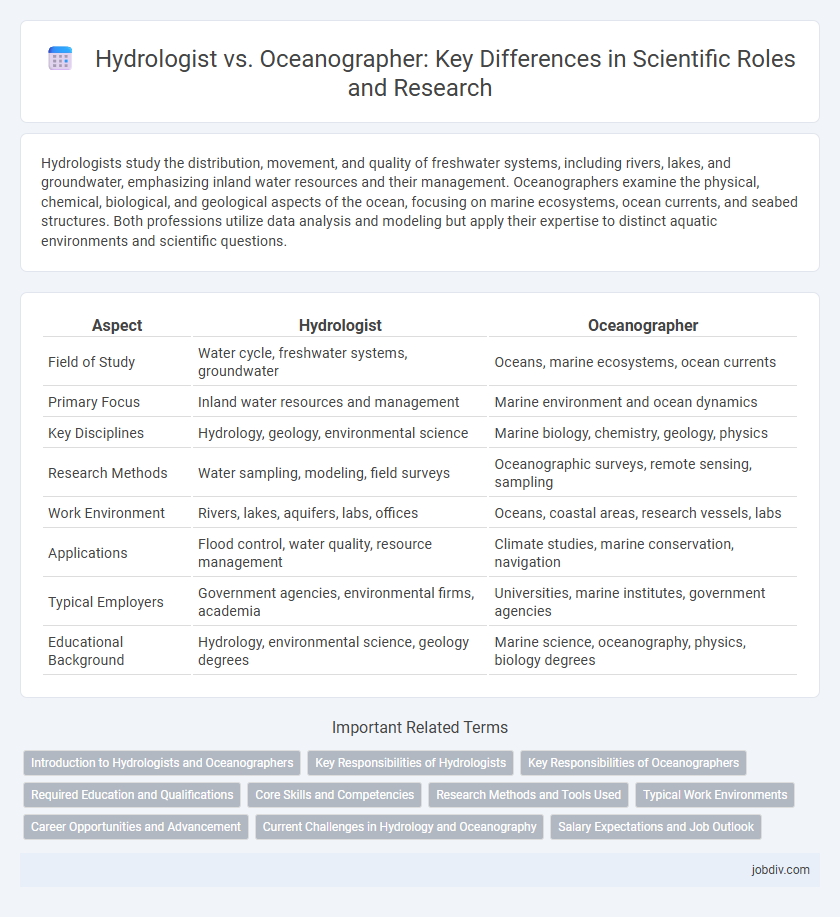Hydrologists study the distribution, movement, and quality of freshwater systems, including rivers, lakes, and groundwater, emphasizing inland water resources and their management. Oceanographers examine the physical, chemical, biological, and geological aspects of the ocean, focusing on marine ecosystems, ocean currents, and seabed structures. Both professions utilize data analysis and modeling but apply their expertise to distinct aquatic environments and scientific questions.
Table of Comparison
| Aspect | Hydrologist | Oceanographer |
|---|---|---|
| Field of Study | Water cycle, freshwater systems, groundwater | Oceans, marine ecosystems, ocean currents |
| Primary Focus | Inland water resources and management | Marine environment and ocean dynamics |
| Key Disciplines | Hydrology, geology, environmental science | Marine biology, chemistry, geology, physics |
| Research Methods | Water sampling, modeling, field surveys | Oceanographic surveys, remote sensing, sampling |
| Work Environment | Rivers, lakes, aquifers, labs, offices | Oceans, coastal areas, research vessels, labs |
| Applications | Flood control, water quality, resource management | Climate studies, marine conservation, navigation |
| Typical Employers | Government agencies, environmental firms, academia | Universities, marine institutes, government agencies |
| Educational Background | Hydrology, environmental science, geology degrees | Marine science, oceanography, physics, biology degrees |
Introduction to Hydrologists and Oceanographers
Hydrologists study the distribution, movement, and quality of water on Earth, analyzing freshwater resources such as rivers, lakes, and groundwater. Oceanographers investigate the physical, chemical, biological, and geological aspects of the ocean, including marine ecosystems, ocean currents, and seafloor geology. Both scientists employ advanced field measurements, remote sensing, and data modeling to understand water systems critical to environmental sustainability and climate change research.
Key Responsibilities of Hydrologists
Hydrologists specialize in studying the distribution, movement, and quality of water resources, analyzing data related to groundwater, surface water, and precipitation to address water management and environmental concerns. They develop models to predict water availability, assess the impact of climate change on hydrological cycles, and provide recommendations for flood control, drought mitigation, and sustainable water use. Their responsibilities often involve field investigations, water sampling, and collaboration with environmental agencies to ensure water resource protection and policy development.
Key Responsibilities of Oceanographers
Oceanographers study the physical, chemical, and biological properties of oceans to understand marine environments and ecosystems. Their key responsibilities include mapping ocean floors, monitoring currents and tides, and analyzing ocean water samples for temperature, salinity, and nutrient levels. They also conduct research on marine life distribution, ocean-atmosphere interactions, and the impact of climate change on ocean systems.
Required Education and Qualifications
Hydrologists typically require a bachelor's degree in hydrology, environmental science, or geology, with many positions favoring a master's degree or PhD for advanced research roles. Oceanographers usually hold degrees in oceanography, marine science, or related fields, often necessitating graduate-level education to conduct specialized studies in marine ecosystems, physical ocean processes, or chemical oceanography. Both professions benefit from strong backgrounds in mathematics, chemistry, and data analysis, with fieldwork experience and internships enhancing job readiness.
Core Skills and Competencies
Hydrologists specialize in analyzing freshwater systems, requiring expertise in groundwater modeling, water quality assessment, and hydrological data interpretation. Oceanographers focus on marine environments, emphasizing physical oceanography, marine chemistry, and ecosystem dynamics. Both professions demand strong analytical skills, proficiency in Geographic Information Systems (GIS), and experience with remote sensing technologies for environmental monitoring.
Research Methods and Tools Used
Hydrologists employ tools like groundwater modeling software, remote sensing, and isotopic analysis to study freshwater systems, emphasizing watershed hydrodynamics and aquifer properties. Oceanographers use sonar mapping, autonomous underwater vehicles (AUVs), and satellite altimetry to investigate ocean currents, marine ecosystems, and seabed morphology. Both disciplines rely heavily on data collection through field sampling and advanced computational modeling to analyze fluid movement in their respective environments.
Typical Work Environments
Hydrologists predominantly conduct research in freshwater systems such as rivers, lakes, and groundwater basins, often working in labs, field stations, and government agencies focused on water resource management. Oceanographers primarily operate in marine environments, including coastal areas, open oceans, and research vessels, with work settings spanning academic institutions, marine research centers, and environmental monitoring organizations. Both professions require extensive fieldwork combined with data analysis in scientific laboratories to study aquatic systems effectively.
Career Opportunities and Advancement
Hydrologists primarily analyze freshwater resources, focusing on groundwater and surface water management, which creates career opportunities in environmental consulting, government agencies, and water resource management firms. Oceanographers explore marine ecosystems, currents, and coastal environments, leading to careers in marine research institutions, environmental organizations, and government agencies like NOAA. Advanced degrees and specialized certifications enhance career advancement prospects in both fields, with leadership roles often requiring expertise in data analysis, environmental policy, and interdisciplinary collaboration.
Current Challenges in Hydrology and Oceanography
Hydrologists face significant challenges in accurately modeling the impacts of climate change on freshwater resources, grappling with complex variables such as altered precipitation patterns and groundwater depletion. Oceanographers confront difficulties in understanding and predicting ocean acidification, which affects marine ecosystems and global carbon cycles. Both disciplines encounter obstacles related to integrating large-scale data from remote sensing and in-situ observations to improve predictive models and resource management strategies.
Salary Expectations and Job Outlook
Hydrologists earn an average annual salary of $84,000, driven by demand in water resource management and environmental consulting, while oceanographers typically command salaries around $90,000, reflecting expertise in marine research and climate studies. The job outlook for hydrologists is projected to grow 7% over the next decade due to increasing water scarcity and infrastructure needs, whereas oceanographers face a 6% growth rate fueled by expanded ocean exploration and environmental monitoring. Both professions require advanced degrees and offer competitive opportunities in government agencies, research institutions, and environmental organizations.
Hydrologist vs Oceanographer Infographic

 jobdiv.com
jobdiv.com